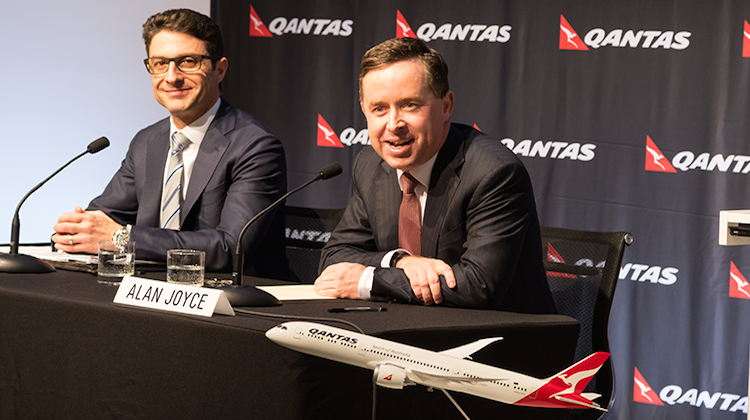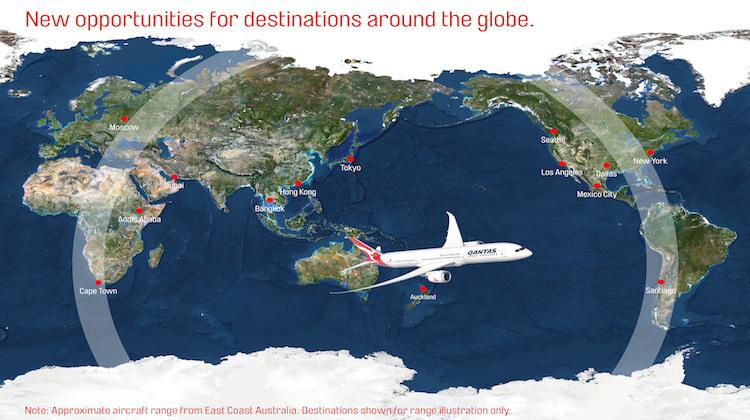
Qantas chief executive Alan Joyce says the Boeing 787-9 Dreamliner will allow the airline to open up new direct services and boost some existing routes to daily.
The company announced on Thursday it would take delivery of eight 787-9s, with the first four to join the Qantas fleet in the 2017/18 financial year and the remaining four in 2018/19.
The eight aircraft are slated to replace five Boeing 747-400s, which will be withdrawn from the fleet prior to requiring a heavy maintenance D check.
Qantas announced the order on the same day it reported a return to profitability in 2014/15 and chief executive Alan Joyce says the decision to purchase the 787 shows the airline has been revitalised and “here for the long haul”.
“This milestone acquisition marks the scale of our turnaround and looks ahead to a new era for our iconic international airline,” Joyce said.
“This is unbelievably exciting for Qantas going forward and we are happy to be in the position to be able to afford the aircraft and get the business case to work.
“This is hugely exciting”.
Joyce had set out three criteria for any potential Dreamliner order, namely Qantas International’s return to sustainable profitability, repaying $1 billion of debt and establishing appropriate staff conditions to ensure the business case for the new aircraft type stacked up.
Qantas said in a slide presentation accompanying the full year results the 787-9’s ultra long range (listed on the Boeing website as 14,140 km with 290 passengers in a two-class configuration) and lower unit costs presented the airline with “future opportunity for growth into markets presently unserved directly from Australia”.
Meanwhile, the lower seat count of the Dreamliner – although no cabin configuration was provided, Joyce said Qantas’s 787-9 would have about 250 seats – compared with the 747-400’s 350-360 seats (depending on configuration) meant there was a “greater level of protection against potential market downturns”.
Qantas estimated the 787-9 used 20 per cent less fuel than the 747-400 and was 15 per cent cheaper to maintain, with the first heavy maintenance check due after 12 years in service.
“It’s got better range, can operate to routes the 747 can’t with full payload, it is a fantastic replacement aircraft with less risk associated with trying to fill up a smaller aircraft,” Joyce said.
“Markets like Melbourne to Dallas open up as an opportunity for us because the aircraft has the potential range to do that in both directions.
“Routes that are long range routes that we don’t fly today, routes that have low levels of traffic volumes that didn’t justify a 747 or routes where we have less than dailies where we would love to get to dailies or routes that we want to fly over a hub and go directly into other destinations not having to fly through LA.”

Qantas’s order consisted of five exercised options and the reallocation of three 787-8 orders for its low-cost carrier subsidiary Jetstar to 787-9s.
The company said it would allocate between $900 million and $1 billion towards capital expenditure in the current financial year, which would include prepayments for the 787-9 order.
Capital expenditure over the following three financial years – 2016/17, 201717/18 and 2018/19 – would total between $3.6 billion and $4.5 billion, representing between $1.2 billion and $1.5 billion per year.
The company has 15 remaining options, which have firm delivery dates and a fixed price, and 30 remaining purchase rights, which have a fixed price but no firm delivery date, for the 787 family that have to be exercised between now and 2024/25.
Joyce said the rest of Qantas’s 747s and A330s would eventually be replaced, with the timing of the fleet renewal program dependent on the performance of the airline in the years ahead.
“We are in a very good position,” Joyce said.
In other fleet news, Qantas said it expected to pick up six aircraft in 2015/16 – two Boeing 717s, three 787-8s (for Jetstar) and one Fokker 100. In terms of withdrawals, one Boeing 747-400 and two Airbus A330-200s would be withdrawn during the year.
Joyce said the addition of eight 787-9s to the fleet represented more opportunities for pilots and cabin crew, given the net addition of three aircraft after the withdrawal of the five 747s.










